11 Indoor Compost Bins For A Low Waste Household
Composting is one of the most beneficial things you can do for our planet.
If everyone composted instead of sending food waste to landfills, we would reduce and sequester (capture) up to 3.13 gigatons of greenhouse gasses by 2050. If we think of CO2 emissions as elephants, that’s equivalent to roughly 600 million elephants!
The benefits of composting are almost too many to count, making it an essential part of any zero waste plan.
You don’t need 5.5 acres or an intricate outdoor composting setup to get in on the composting game. With the availability of various indoor compost bins, anyone anywhere can responsibly transform their food scraps and reduce their footprint.
With compost collection bins like those from Bamboozle, a sleek countertop accessory is all you need to get started.
You can also invite thousands of guests (worms) into your home with an indoor worm compost bin from Uncommon Goods.
While the Vitamix FoodCycler isn’t a large indoor compost bin, it functions like one! It shrinks food waste to just a fraction of its size in mere hours, provides nutrient-rich goodness that can be mixed into the soil and can be run multiple times a day.
If this is too high-tech and you want to go the opposite route (DIY), we’ll also provide some tips for creating a homemade indoor compost bin.
Regardless of which method you choose, be sure to read up on what you can and can’t compost:
- What is Compostable? 101 Things You Can Compost Right at Home
- What’s Not Compostable? 33 Things You Can’t Compost at Home
Jump to the end of this article to see more information on types of kitchen compost bins and some thoughts on how to choose the best bin.
*This post contains affiliate links
QUICK LINKS FOR INDOOR COMPOST BINS
Simple Indoor Compost Collection Bins
Indoor Worm Compost Bins
Simple Indoor Compost Collection Bins
Some of us are lucky enough to have a food scraps collection service in our area.
In this case, you don’t need to go through the entire composting process in your kitchen or garden if you don’t want to—all you need is a simple indoor compost bin caddy! If that’s the case, consider what you already have (we just use an old Tupperware, which works perfectly).
If you’re in need of something new, however, the following are some great options.
1. NATURAL HOME BRANDS
Natural Home Brands’ Ceramic Indoor Compost Bin
The one-gallon Ceramic Compost Bin from Natural Home Brands is made with a non-toxic, lead-free glaze and has an odor-negating charcoal filter in the lid.
Available: EarthHero
2. BAMBOOZLE
Bamboozle’s Small Indoor Compost Bin
Bamboozle makes one of the best indoor compost bins for collecting food scraps (so perhaps the better term would be pre-composting bin).
It has a sleek modern design, and, being made with biodegradable bamboo fibers, can be composted itself!
It’s dishwasher safe, freezer-safe, and comes with a breathable lid and odor-blocking carbon filter.
Available: Food52
3. L’ÉCHOPPE À BOIS
L’Échoppe à Bois Indoor Kitchen Compost Bin
This Quebecois Etsy shop has a few gorgeously-made compost collection bins.
Every bin from L’Échoppe à Bois is handcrafted in a family workshop out of locally-sourced wood (like Cedar), which helps to mask bad odors.
Available: Etsy
4. PACKAGE FREE
Package Free’s Indoor Compost Bin Container
Made with stainless steel, the plastic-free compost bin by Package Free Shop is easy to clean and certain to last a lifetime.
Plus, it’ll blend in seamlessly with the rest of your stainless steel ethical appliances!
To keep things fresh, it comes with a replaceable cotton and activated charcoal filter.
Available: Package Free
5. SIMPLE HUMAN
Simple Human’s Compost Bin Indoor Kitchen
Simple Human wants to make being human, well, simple!
Okay, maybe they can’t make everything simple, but they can at least simplify your kitchen waste management.
The best thing about this compost caddy is that, if you have a Simple Human trash can, it can be conveniently docked on the side.
It can also be placed on the countertop, and has a magnetic docking system that can hold the lid open for convenient cutting, scraping, and peeling.
Available: Amazon | Simple Human
Indoor Worm Compost Bins
Have you ever found yourself wondering, “What do worms eat?”
Wonder no more!
Aside from meat, dairy, and citrus, a worm’s diet is much the same as our own—except they’re not as picky about the condition and parts as we are.
That’s why worms are nature’s perfect composters and why a vermicomposting bin is one of the best indoor composting bin solutions.
6. UNCOMMON GOODS
Uncommon Goods’ Living Composter
The odorless biomorphic indoor worm compost bin from Uncommon Goods is uniquely shaped based on an algorithm, which explains why it can process up to two pounds of food a week.
With separate compartments for adding food scraps, worms, and removing soil, it makes it easy to use the finished compost (and the nutrient-rich worm castings it contains).
Plus, it’s made from sustainable materials like cork and recycled plastic!
Available: Uncommon Goods
7. SACRED RESOURCE
Sacred Resource’s Indoor Worm Bin Composters
From Steamboat Springs, Colorado, Sacred Resource makes beautiful vermicomposters from upcycled beetle-kill pine.
The locally harvested wood is sourced from trees killed by the mountain pine beetle, reducing what often becomes wildfire fuel and leaving the wood a beautiful blue-cream color.
You can opt to add a custom metal drip pan, useful for making your own worm tea!
Available: Etsy
8. URBALIVE
Urbalive’s Indoor Vermicomposting Bin
The Urbalive Worm Farm has to be the best-looking worm farm we’ve ever seen.
It has that Nordic, minimalist look about it and would look amazing in anyone’s home (regardless of whether you opt for classic beige or grey or the more eye-catching lime green).
Much like other worm farms and bins, the odor-free system comes with tiered trays where the worms convert scraps into compost and worm tea which can be added to your backyard or apartment garden.
Available: Amazon (US) | Amazon (UK)
Bokashi and Similar Indoor Compost Bins
9. BOKASHI
Bokashi Indoor Compost Bins
The Bokashi process can convert meat, bones, fish, citrus, and onion (all food scraps that can’t be directly fed to worms) into more easily consumed worm food and/or compost input.
Simply combine food scraps with Bokashi bran, which contains microorganisms that do the breaking down. The scraps become “bokashi waste” which can either be buried in the garden, fed to a worm bin, or added to a traditional compost bin or pile.
We use 2 bins (one for collecting and one for composting) and can happily say that none of our food waste goes into the trash!
Available: Amazon (US) | Ethical Superstore (UK) | Biome (AU)
10. URBAN COMPOSTER
Urban Composter Bucket Indoor Compost Bin
The Urban Composter falls somewhere in between collection bucket and full-on composter.
It uses the bokashi method, which relies on an oxygenless environment to ferment food with the assistance of a citrus-based accelerator spray. In just a few days, liquid fertilizer leachate (compost juice) can be collected.
Continue to add food scraps as the older ones are fermenting until the bin is full.
The finished decomposed food scraps (not finished compost) can be added to topsoil to add slow-release nutrients.
Available: Amazon (US) | Biome (AU)
Complete Indoor Compost Systems
11. VITAMIX
Vitamix’s FoodCycler
Vitamix may be known for their professional-quality blenders, but their FoodCycler FC-50 is just as essential for any foodie.
It reduces food waste to a fraction (around one-tenth) of its original size in the span of 7-8 hours. Mix the remnant food scraps directly into the soil or add them to another compost bin to fully become humus (in a much shorter period of time!).
It’s one of the few compact food recycling systems that can process fruit, veggies, dairy, and bones—and do so in an efficient, quiet, and odorless way.
Available: Vitamix
12. DIY INDOOR COMPOST BIN
For a super-friendly way to handle your food waste, consider making a DIY indoor compost bin or DIY indoor worm compost bin.
How to make an indoor compost bin? The process is pretty simple:
- For a small, countertop version made with just a plastic lid and nylon mesh screen, check out the instructions from Better Homes and Gardens.
- For something a little larger (suitable for a basement, perhaps), Young House Love has tips for a budget indoor compost bin that makes use of a large storage bin container.
- Using the same type of containers, you can make a DIY worm farm. Make sure you have two plastic bins with lids and be sure that they’re opaque (worms don’t like a lot of light). Check out Modern Farmer for specific instructions.
Epic Gardening has an excellent video on how to build a stackable DIY worm farm. Spoiler alert: it’ll only cost $30!
TYPES OF KITCHEN COMPOST BINS
Simple indoor compost collection bins:
To clarify, not all “compost bins” bins actually compost. These just collect food waste and often have some sort of filter to minimize odors.
These are designed to be used before one of the other types of compost bins or to collect food scraps in between weekly curbside composting pickups.
Indoor worm compost bins:
These use worms (typically red wrigglers) to break down food scraps into worm castings (AKA poop) that can be steeped into a concentrated liquid fertilizer and fed to your plants. This is called worm tea.
Worms aren’t picky eaters by any means; they just need a little extra care (they’re living beings after all).
The biggest benefit to these is they can be kept inside without smelling or attracting bugs.
Bokashi and similar indoor compost bins:
The word “Bokashi” is Japanese for “shading off” derived from methods used centuries ago to ferment food.
The method typically involves throwing food scraps into a bin, along with a mix of microorganisms (purchased separately).
The Bokashi method doesn’t entirely convert your food scraps into rich compost, but turns them into another form of waste that can go straight into the garden or into a worm farm/traditional composter for further breakdown.
Complete indoor compost systems:
These typically come in plastic or metal bins and use aeration and moisture retention (emulating nature) to decompose your organic matter.
Some indoor compost bins use electricity to fast-track the process of breaking down food scraps.
The waste that comes out can be buried in your garden (or in your recycled plant pots) or added to a worm bin/traditional compost bin.
HOW TO CHOOSE THE BEST INDOOR COMPOST BIN
When choosing the best indoor composter for your lifestyle, ask yourself:
1) How much space do you have?
Take a look at your living space and determine where you might put one. On the counter? Beneath the sink? In a closet?
Use this to determine the best indoor composter for you.
2) What is your budget?
3) How much work do you want to put in?
There is generally a trade-off between 2 and 3, but if you live a busy life and don’t have time to compost or plan on doing a lot of composting, a more expensive vessel is worth the investment.
Plus, if you eat a lot of meat and dairy, you’ll likely need a more complete system that is as air-tight as possible. Being vegan certainly makes composting a little less complicated!
You should also be aware that leakage and odors have been reported by fellow composters as an annoyance when composting inside.
There are ways to avoid this, such as adding dry bedding to the bottom of the bin to prevent leakage and making sure you’re sticking to the rules of what can and cannot be added.
FINAL THOUGHTS ON INDOOR COMPOST BINS
We hope we’ve been able to help in your search for the perfect kitchen composting bin.
Just by choosing to compost your organic waste, you’re choosing to reduce your own landfill waste by up to 50%.
That’s about 0.42 pounds per person in your house per DAY.
Make that nearly pound of waste diverted from landfills even bigger by sharing this article with a friend or family member! If we all feel compelled to compost, we can truly stop breaking down our planet.
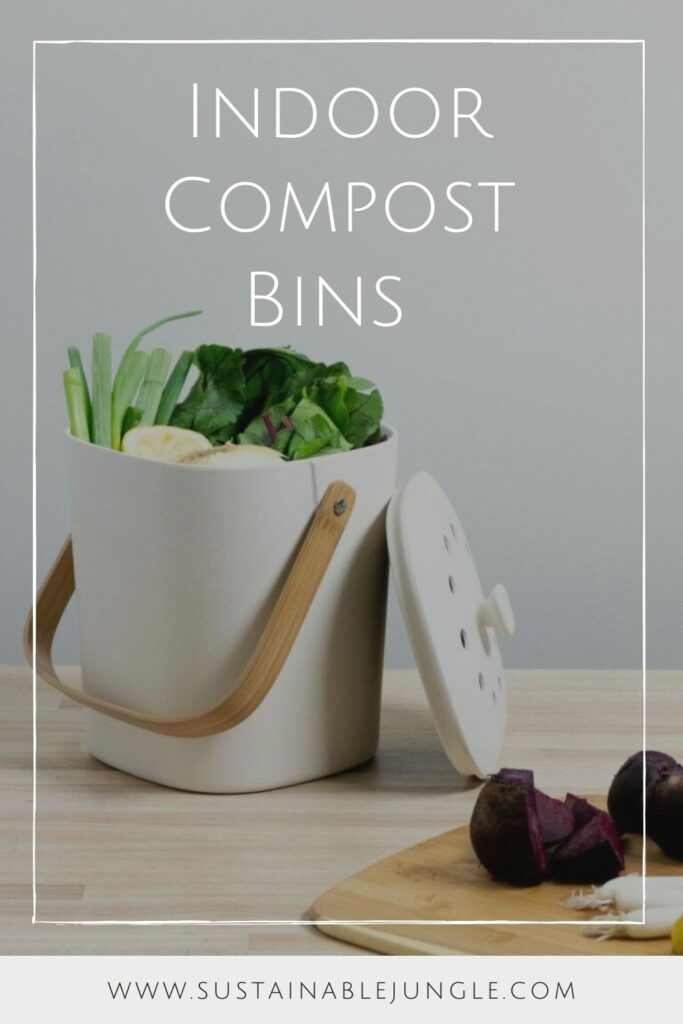

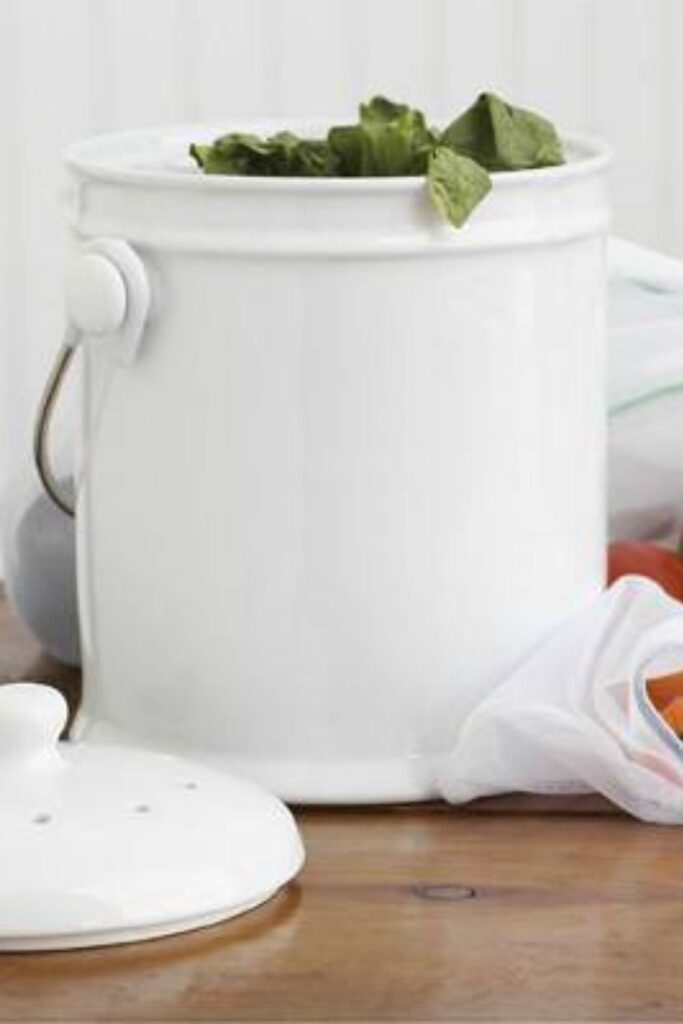
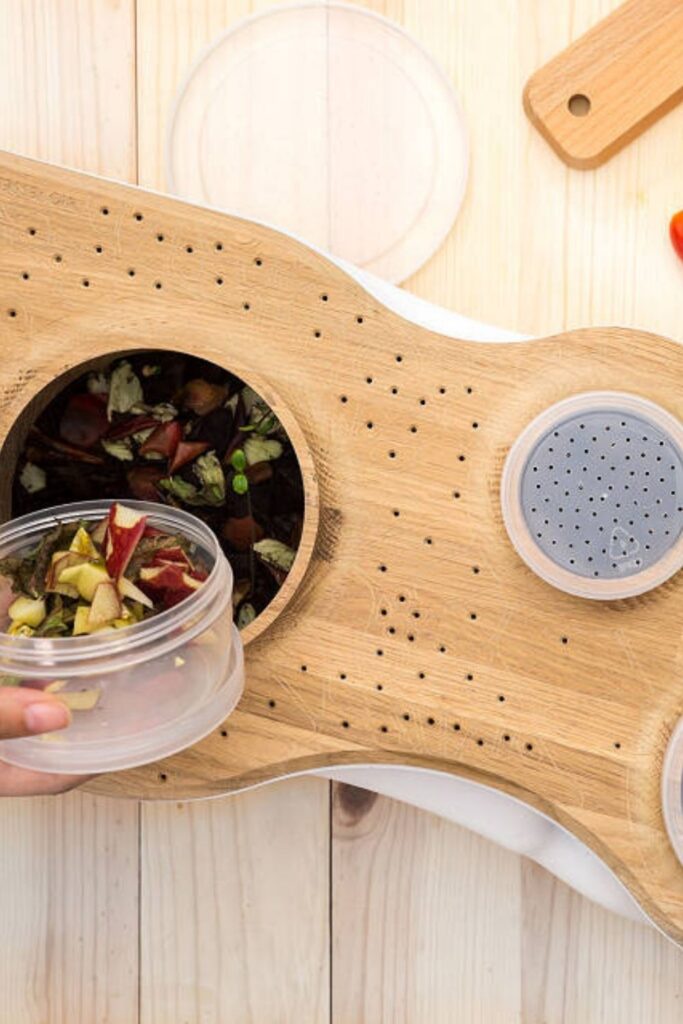
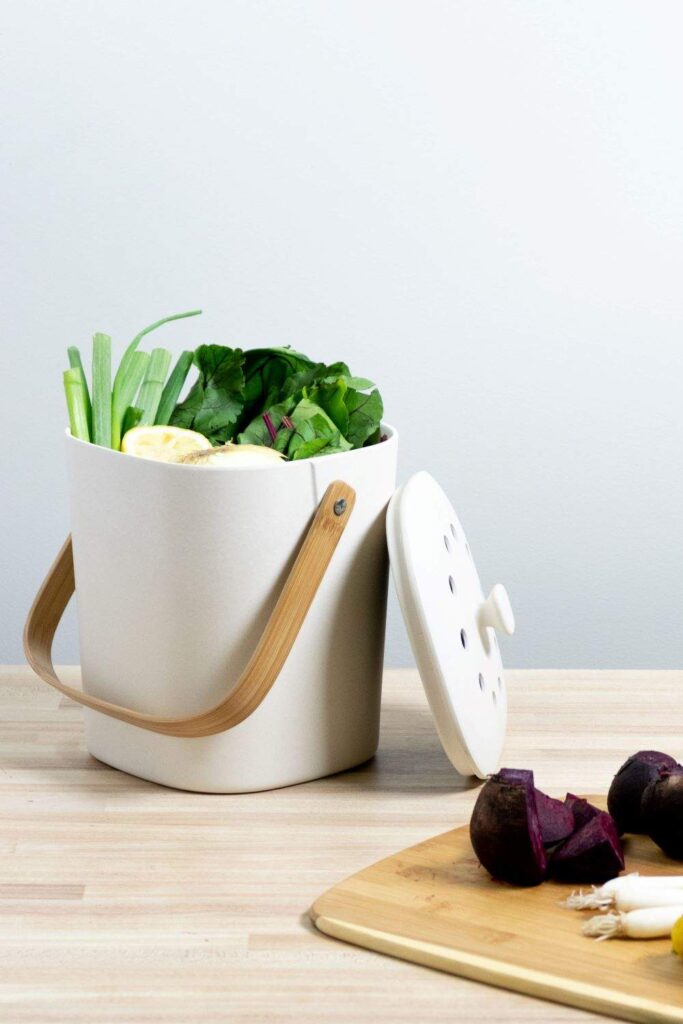
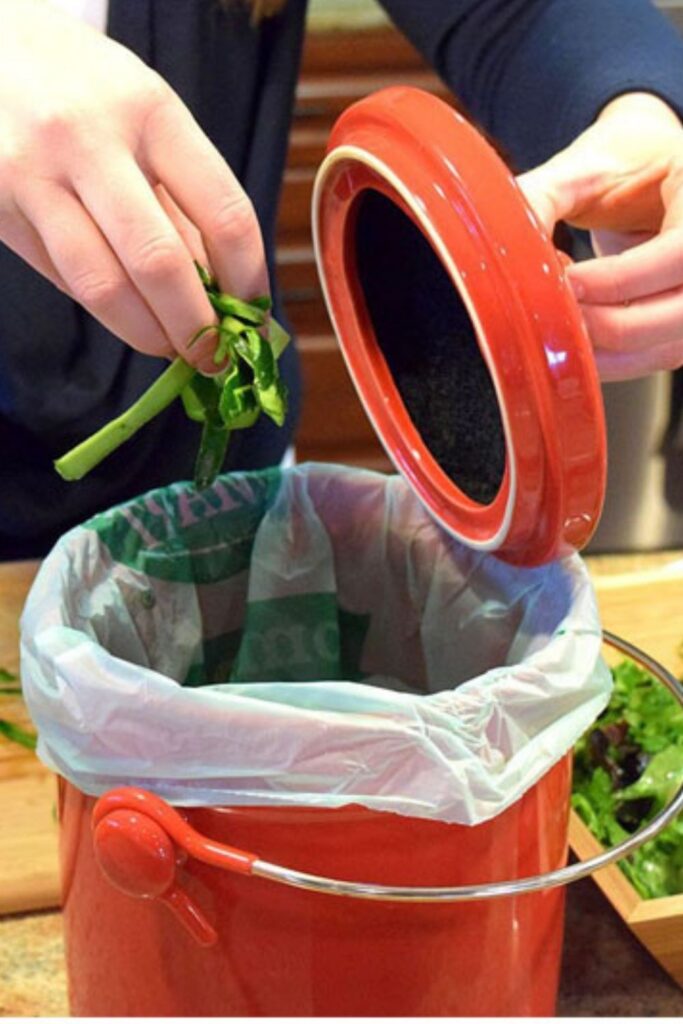
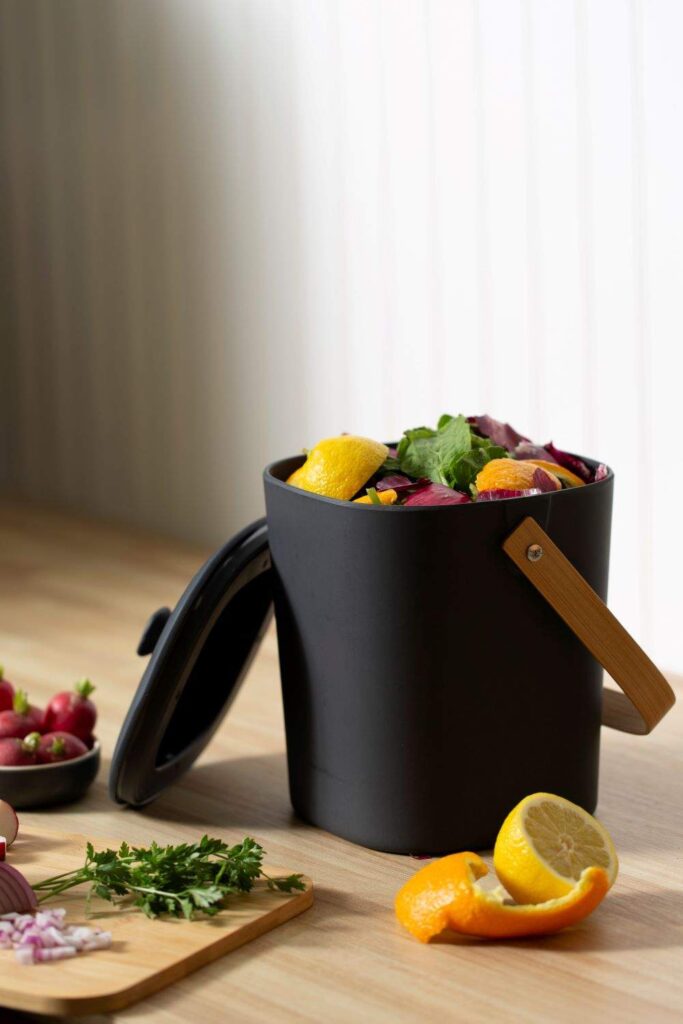
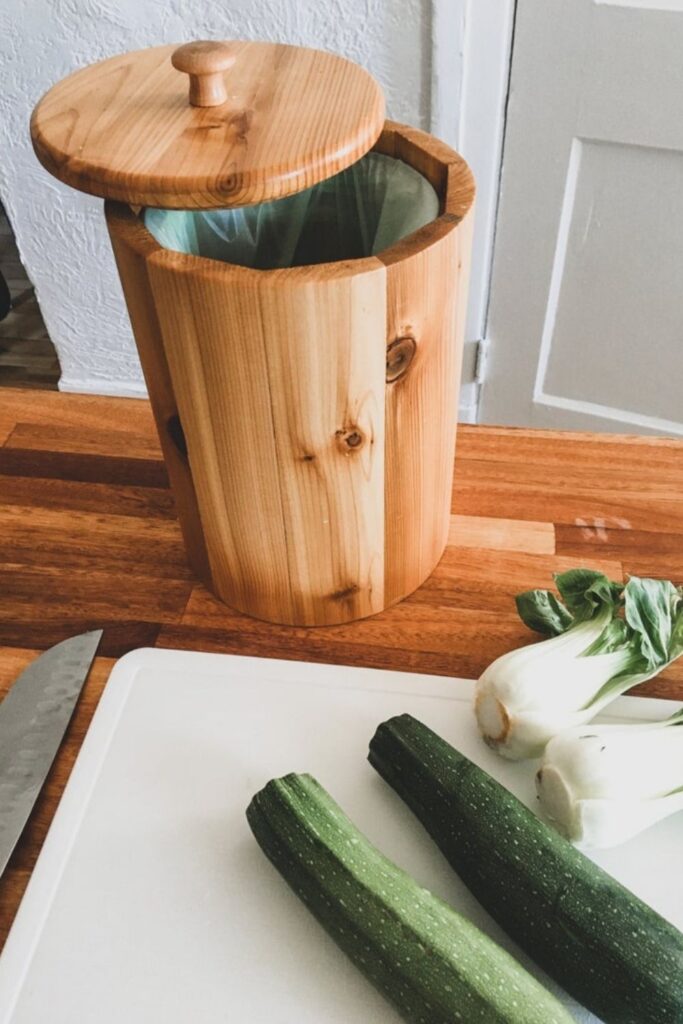
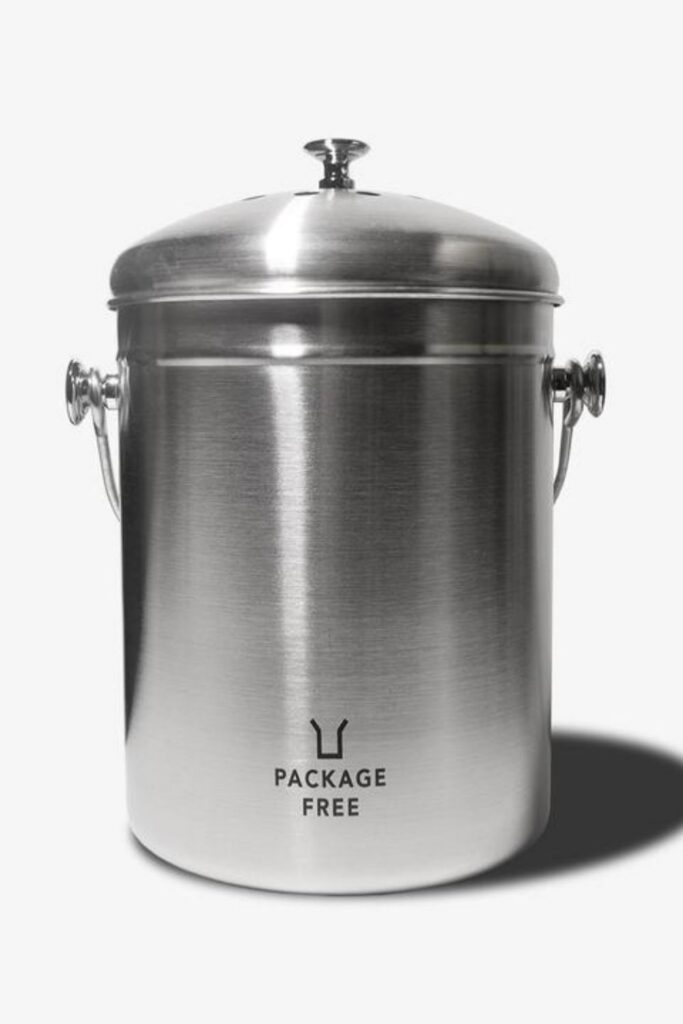
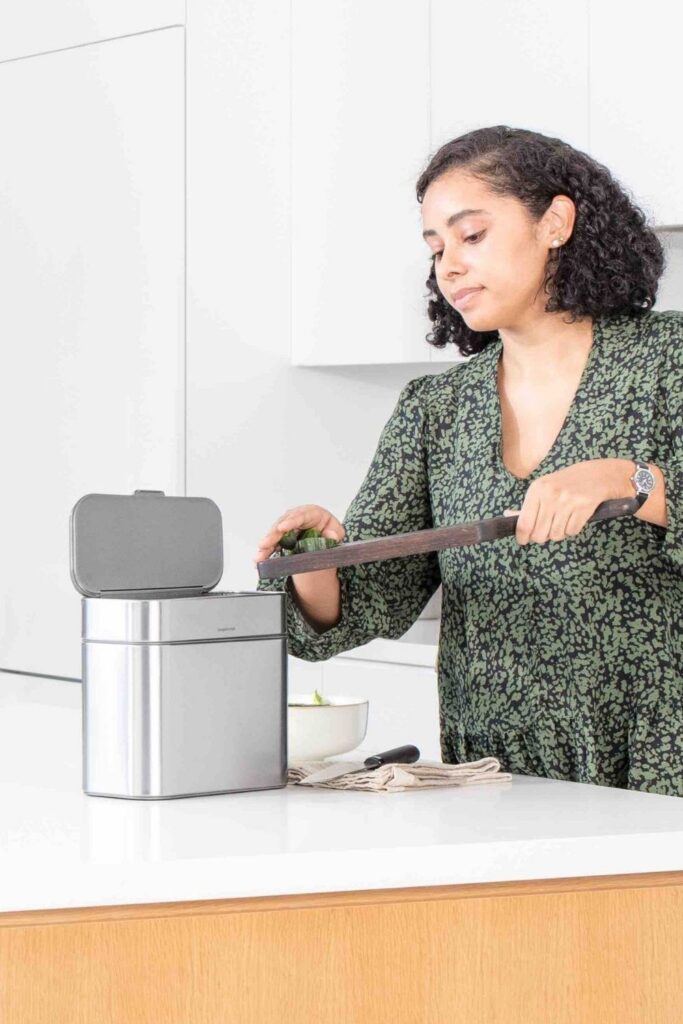
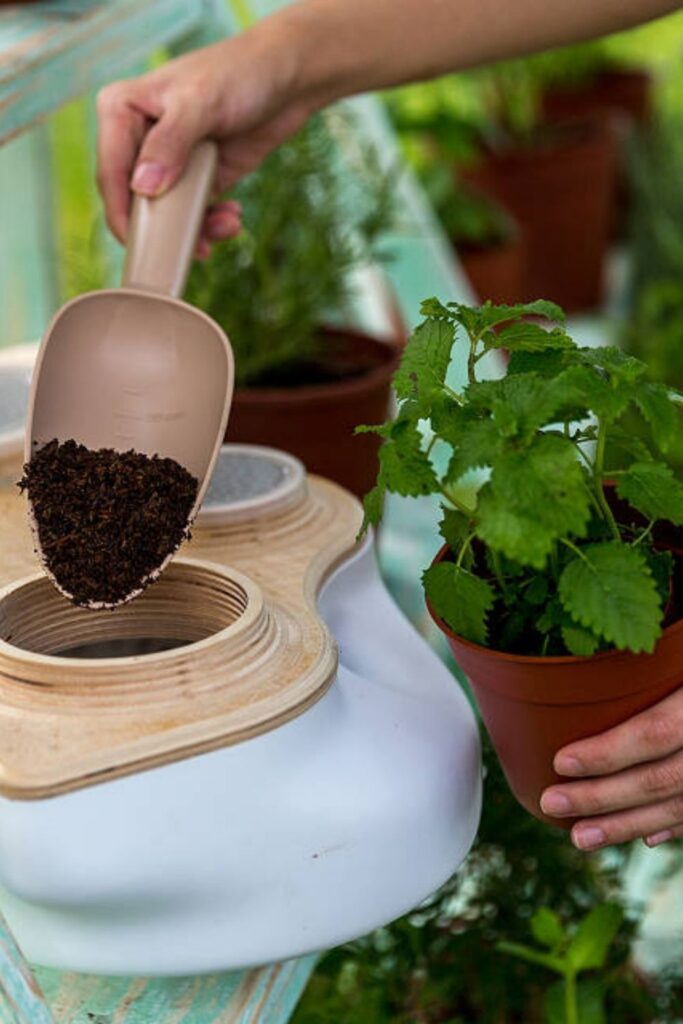
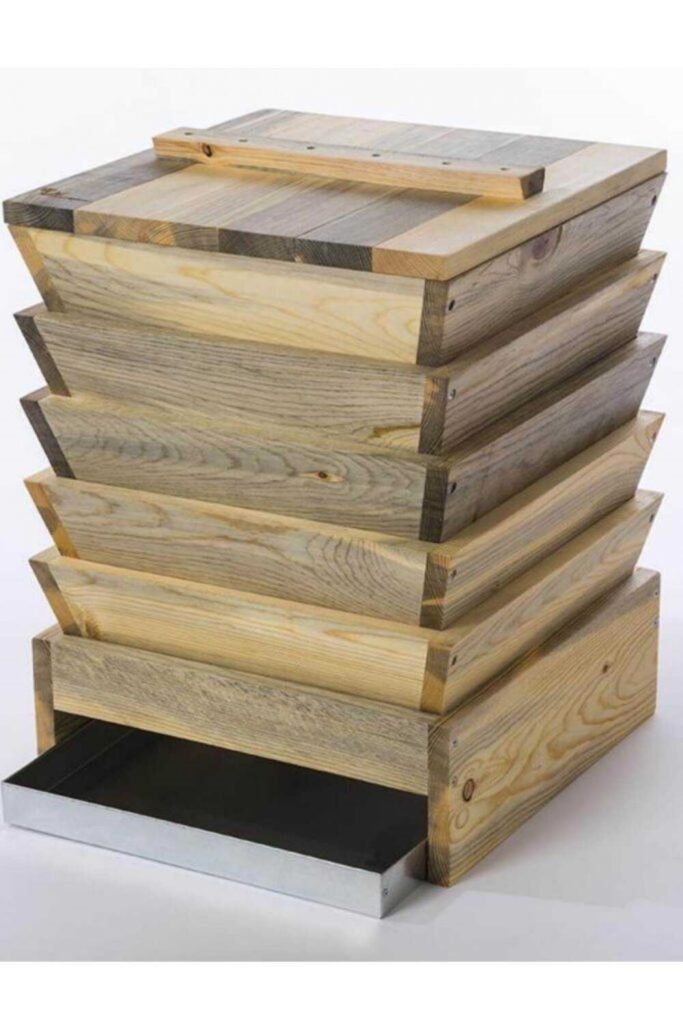
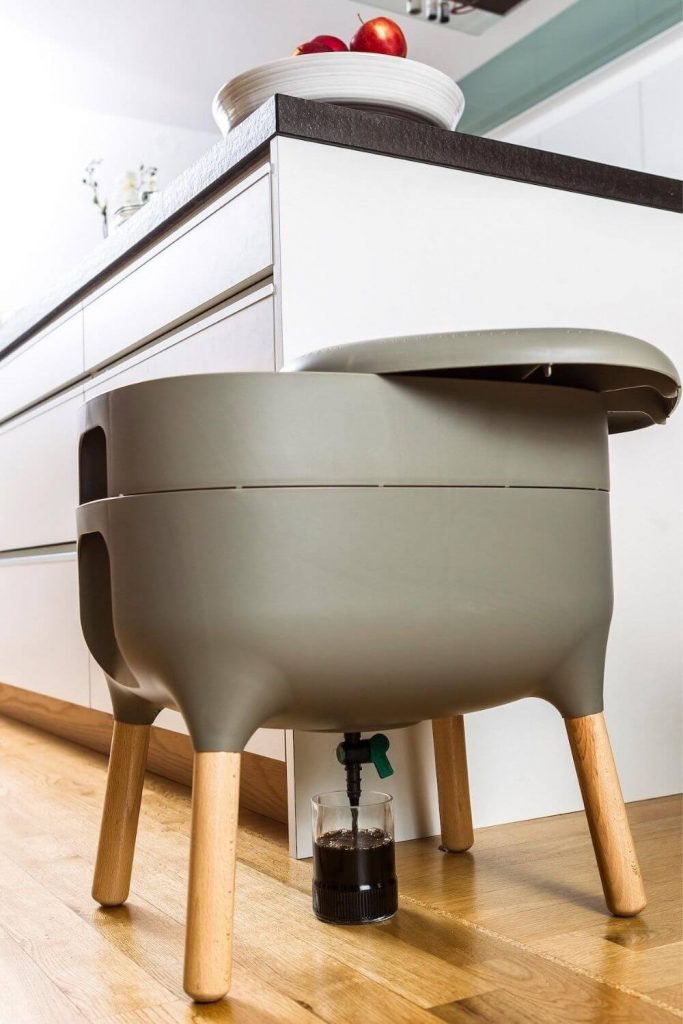

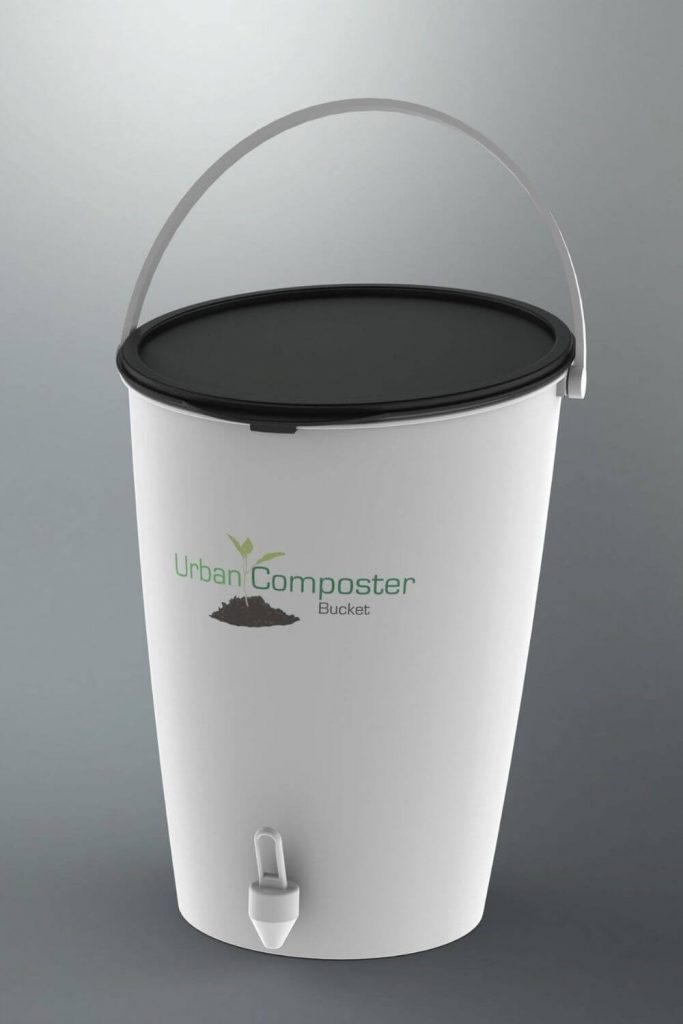
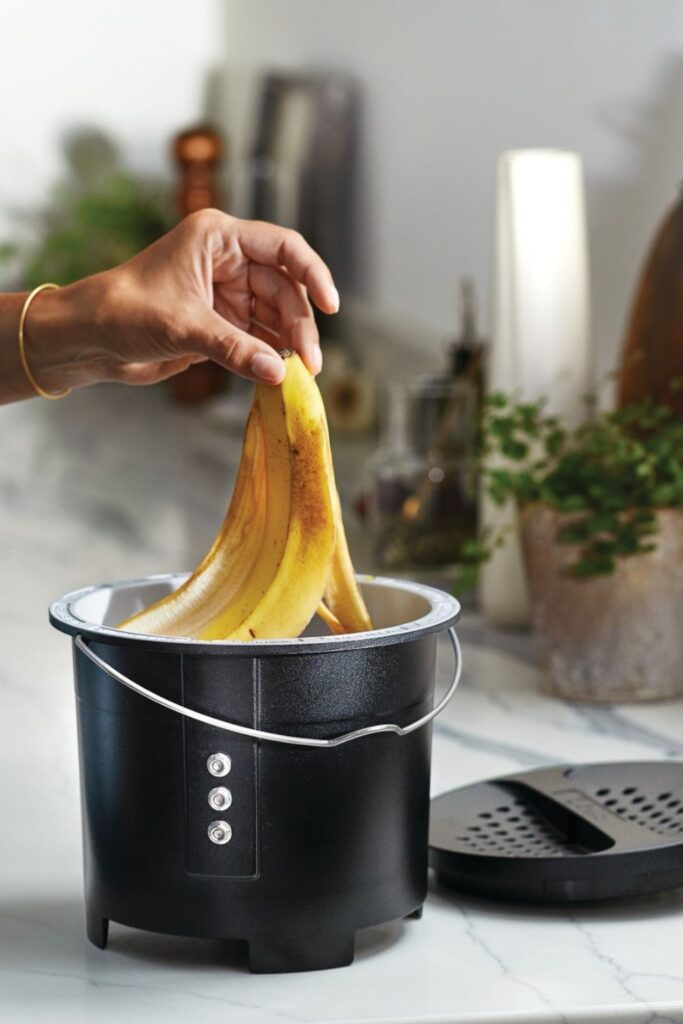

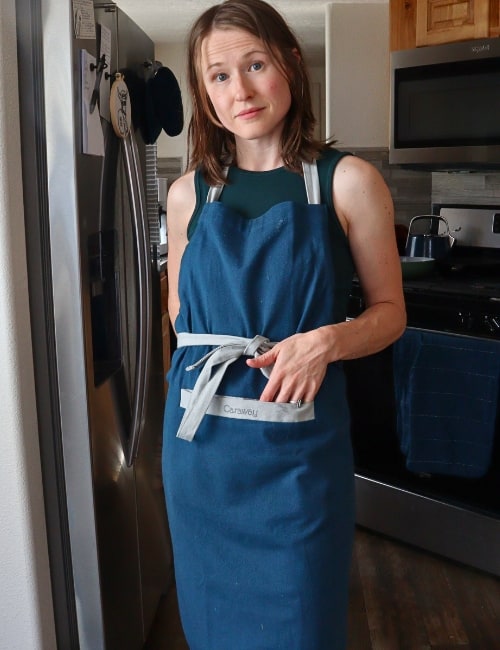
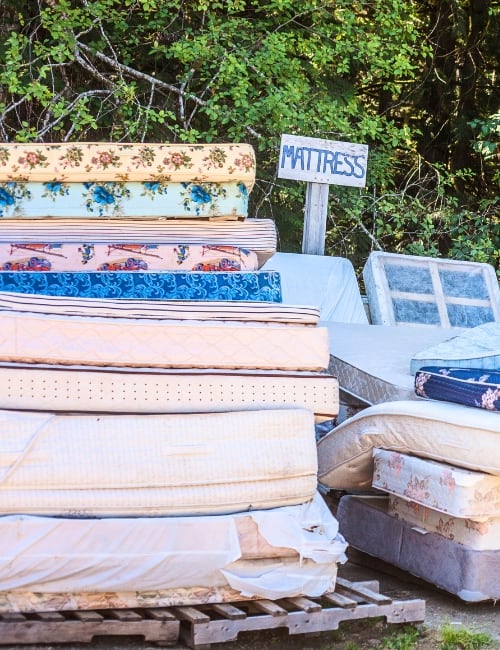
What about LOMI? Is this recommended as an indoor compost option in catagory of vitamix?
Hey skeeter, yea I saw these composters pop up on my radar the other day, we’ll take a look at them when we next update the article! Thanks for the note, super helpful!
Indoor compost bins though sound and smells nasty, I guess the smell can be handled with better installation I guess. Would not mind having my own compost pit and use it as fertilizer for my indoor plants and herb garden.
Yea, the indoor ones can be tricky, especially those that are not as well made. If you can do it outdoors, it is a better option!
I thought the foto was your foto! Do you compost? Was hoping to get a glimpse of what your composting schedule consists of.
Hi Jessica,
Thanks for visiting! No that’s not our photo! Our vermi-composter is black and not quite as photogenic as that nice green one 🙂 so we decided to use that instead.
But yes, we personally compost in 3 ways:
– We have a vermi-composter outside on our balcony which has worms in it. These little guys eat some of our food scraps but not all so we need other options too – we “feed” this worm bin once a week and drain the worm tea which we feed to our balcony garden – our plants love it! Read more about worm tea here . We could actually have this vermi-composter indoors in our apartment as it doesn’t smell and is pretty compact, but we’re lucky and have a big balcony so we keep it out there instead.
– We have 2 bokashi bins on the kitchen counter which we use for things like citrus peels and onions which worms don’t like to eat – one of these takes 2-3 weeks to fill up and then we use the other one, while the first Bokashi does it’s thing
– For everything else, we collect scraps in a bucket which we take to a local community garden (every 2 weeks or so) that composts a huge amount of food scraps. We found the community garden on ShareWaste – My Mom also used this site to find out that her Neighbour likes to collect food scraps for her compost so they now have quite a nice arrangement – so it doesn’t have to be a community garden that you deliver your scraps to,it could just be someone in the community.
We’re thinking about adding a more traditional composter to our collection but the above is working well for us right now. Do you compost? If not, what are you thinking about doing? We are HUGE fans of composting, we no longer have smelly bins and we feel good about not sending organic matter to landfill… plus as I said, the plants love it!
Thanks again for visiting!
Joy